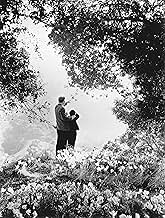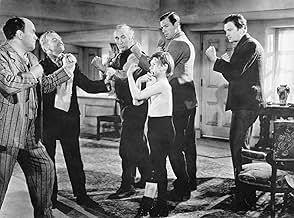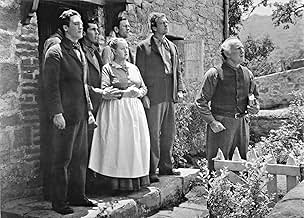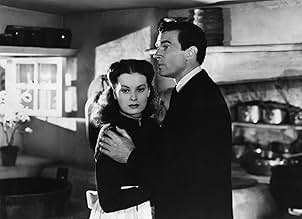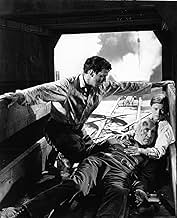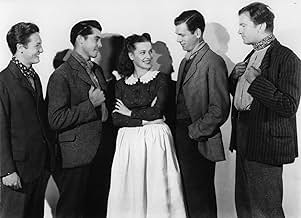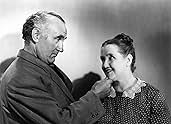A la fin du 19è siècle au Pays de Galles, la vie d'une famille de mineurs vue par plus le jeune des enfants, Huw: le travail difficile, les accidents, les peines, les joies, les combats, les... Tout lireA la fin du 19è siècle au Pays de Galles, la vie d'une famille de mineurs vue par plus le jeune des enfants, Huw: le travail difficile, les accidents, les peines, les joies, les combats, les renoncements, les espoirs pour Huw.A la fin du 19è siècle au Pays de Galles, la vie d'une famille de mineurs vue par plus le jeune des enfants, Huw: le travail difficile, les accidents, les peines, les joies, les combats, les renoncements, les espoirs pour Huw.
- Réalisation
- Scénario
- Casting principal
- Récompensé par 5 Oscars
- 19 victoires et 6 nominations au total
- Ceinwen
- (as Ann Todd)
Avis à la une
There is not much, if anything, to criticize in this movie, it's one of the best ever.
But sometimes it seems too good to be true:the boss's offspring marrying a miner's daughter,even when she's a beauty like Maureen O'Hara?The boss asking the poor father's permission?We are far from Emile Zola's "Germinal" :both stories happen about during the same era ,both with the miners' life both are radically different.Zola's world is a bleak,desperate world ,his depiction of the families' houses and meals (when there is food) and the pictures of Ford's movie are worlds apart.But the biggest difference is the omnipresence of the Lord's will:in "how green" the minister is a cool young handsome man (Pidgeon),in "Germinal" ,the priest's only a silhouette,but a selfish cruel one,unconcerned to man's plight:Zola's miners do not put their trust in a God anymore .
Wales and the east of France ,were they that much different?You can only say they were novels and movies,and reality is probably somewhere between them.
Walter Pigeon is the likable minister, and lead character, "Mr. Gruffydd." He's likable because he doesn't judge people as the head deacon does. The latter is portrayed ludicrously by Barry Fitzgerald, much to the delight of secular-minded film critics, who loved his performance. Nonetheless, there is a lot of "religion" pictured positively in this film, a lot of spiritual scenes and most were done well.
Roddy McDowell plays the most memorable character, I thought: "Huw," a young boy who went through some really tough times, as did most of the townsfolk.
If you are used to modern films, be warned this film does drag in spots. It is a fine movie, to be sure, and a powerful and emotional story.
It's like Ford's Liberty Valance in that it shows the progress that the world's first industrial society, 19th century Great Britain as reflected in that Welsh valley, just like the settling of the American West in The Man Who Shot Liberty Valance. It's the reverse here, the valley is a place people leave, or at least a lot of the good ones. Nearly all the Morgan children and Walter Pidgeon who plays the minister.
1941 and 1942 marked the high point in the career of Walter Pidgeon. He never quite made the top rung of actors at his home studio of MGM. Yet in those two years he happened to star in both the films the Academy designated as Best Picture, this one and Mrs. Miniver in 1942. He's an outsider, arriving full of ideals and then forced to leave to stop gossip about him and Maureen O'Hara.
Maureen O'Hara made her John Ford debut in How Green Was My valley as the lovely and fetching Angharad. She and Pidgeon are in love, but Pidgeon does not want to inflict is life of denial on her. They give each other up and later their relationship is the cause of gossip.
Arthur Shields the lesser known brother of Barry Fitzgerald is the head of the deacons at Pidgeon's church. A narrow, bitter man he's one of a string of religious hypocrite characters that Ford has in his films. Offhand I can think of Willis Bouchey in The Last Hurrah and Grant Withers in Fort Apache. Barry's in this too, playing the comical Cynfartha.
The center of the film is the Morgan family headed by Donald Crisp and Sara Allgood. Playing Morgan patriarch Gwyllym Morgan, Crisp gets the Best Supporting Actor for this wonderful portrayal of strength and dignity. Sara Allgood matches him every step of the way.
Besides Pidgeon and O'Hara, the rest of the film revolves around the generational conflicts between the conservative father and his more broadminded sons who want to get a union started. In 1941 America that was a timely theme as our American Labor movement got its first backing from a friendly government in the New Deal. The labor troubles that the Morgans and the other Welsh coalminers in the valley deal with was a very relevant.
One of the great things about this is that Ford never takes sides here. Donald Crisp is never shown as a reactionary fool for his opposition to unionization. Indeed Ford puts him on a pedestal for sticking to his beliefs.
All this is seen through the eyes of young Hugh Morgan, played by Roddy McDowall in his first major part as a juvenile and narrated in flashback by British actor Irving Pichel as the adult Hugh. McDowell has his own troubles here, he and Sara Allgood fall in a freezing river and both have health problems afterward. McDowell is the first of the Morgans to go to school and he's bullied by both pupils and a snobbish teacher. Young McDowell is taught to box by Rhys Williams to take care of the kids and later Rhys Williams as Dai Bando, an ex-pugilist takes matters in his own hands with the teacher in the films most hilarious scene.
As we move into the post industrial age, the labor themes of How Green Was My Valley seem quaint. But the family travails, and heartaches, and triumphs with that 19th Century Welsh Coalmining family are timeless. This is the real genius of John Ford.
Oscars Best Picture Winners, Ranked
Oscars Best Picture Winners, Ranked
Le saviez-vous
- AnecdotesHistorians have called the way the wind plays with O'Hara's veil when she leaves the church after her wedding a stroke of luck for John Ford. Far from it, he had instructed the crew to set up wind machines to fan the veil into a perfect circle behind her head then blow it straight up into the air.
- GaffesThe wage reduction proclamation contains the word "labor" (American spelling) rather than "labour" as any British Islander would spell it.
- Citations
Mr. Gruffydd: You've been lucky, Huw. Lucky to suffer and lucky to spend these weary months in bed. For so God has given you a chance to make the spirit within yourself. And as your father cleans his lamp to have good light, so keep clean your spirit... By prayer, Huw. And by prayer, I don't mean shouting, mumbling, and wallowing like a hog in religious sentiment. Prayer is only another name for good, clean, direct thinking. When you pray, think. Think well what you're saying. Make your thoughts into things that are solid. In that way, your prayer will have strength, and that strength will become a part of you, body, mind, and spirit.
- Versions alternativesOriginal stereophonic soundtrack recovered and restored for later video and cable TV release.
- ConnexionsEdited into Au coeur du temps: End of the World (1966)
- Bandes originalesRhyfelgyrch Gwyr Harlech
(uncredited)
(Men of Harlech)
Traditional Welsh folk song
Played and Sung during the opening credits
Meilleurs choix
Détails
Box-office
- Budget
- 1 250 000 $US (estimé)
- Montant brut mondial
- 865 $US
- Durée1 heure 58 minutes
- Couleur
- Rapport de forme
- 1.37 : 1
Contribuer à cette page



